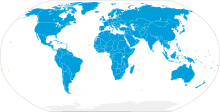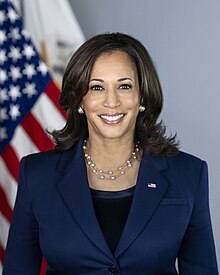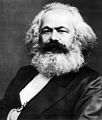
Back Portal:Politik ALS بوابة:السياسة Arabic بوابة:سياسة ARZ Портал:Политика Bulgarian প্রবেশদ্বার:রাজনীতি Bengali/Bangla Portal:Politika BS دەروازە:سیاسەت CKB Portál:Politika Czech Portal:Politik German Portal:Siyaset DIQ
| Main | Topics and categories | Tasks and projects |
The Politics portal
Politics (from Ancient Greek πολιτικά (politiká) 'affairs of the cities') is the set of activities that are associated with making decisions in groups, or other forms of power relations among individuals, such as the distribution of resources or status. The branch of social science that studies politics and government is referred to as political science.
It may be used positively in the context of a "political solution" which is compromising and non-violent, or descriptively as "the art or science of government", but also often carries a negative connotation. The concept has been defined in various ways, and different approaches have fundamentally differing views on whether it should be used extensively or in a limited way, empirically or normatively, and on whether conflict or co-operation is more essential to it.
A variety of methods are deployed in politics, which include promoting one's own political views among people, negotiation with other political subjects, making laws, and exercising internal and external force, including warfare against adversaries. Politics is exercised on a wide range of social levels, from clans and tribes of traditional societies, through modern local governments, companies and institutions up to sovereign states, to the international level.
In modern nation states, people often form political parties to represent their ideas. Members of a party often agree to take the same position on many issues and agree to support the same changes to law and the same leaders. An election is usually a competition between different parties.
A political system is a framework which defines acceptable political methods within a society. The history of political thought can be traced back to early antiquity, with seminal works such as Plato's Republic, Aristotle's Politics, Confucius's political manuscripts and Chanakya's Arthashastra. (Full article...)
Selected article
Regulamentul Organic was a quasi-constitutional organic law enforced in 1831–1832 by the Imperial Russian authorities in Moldavia and Wallachia (the two Danubian Principalities that were to become the basis of the modern Romanian state). The official onset of a common Russian protectorate lasting until 1854, and itself officially in place until 1858, the document signified a partial confirmation of traditional government (including rule by the hospodars). Conservative in its scope, it also engendered a period of unprecedented reforms which provided a setting for the Westernization of local society. The Regulament offered the two Principalities their first common system of government.
Featured picture

Photo taken by a Lockheed U-2 spy plane of the San Cristobal MRBM launch site in Cuba, November 1962, after the Cuban Missile Crisis. Although this image was taken days after the crisis had ended (October 28), this image has become iconic of the crisis to the point where it is often cited incorrectly as having been taken during the crisis.
The Premier of the Soviet Union (Russian: Глава Правительства СССР) was the head of government of the Union of Soviet Socialist Republics (USSR). From 1923 to 1946, the name of the office was Chairman of the Council of People's Commissars, and from 1946 to 1991 its name was Chairman of the Council of Ministers. During the dissolution of the Soviet Union in 1991, its name was briefly Prime Minister and Chairman of the Committee on the Operational Management of the Soviet Economy. The first Soviet premier was the country's founder and first leader, Vladimir Lenin. After 1924, when General Secretary of the Communist Party Joseph Stalin rose to power, the de facto leader was the party's General Secretary, with Stalin and his successor Nikita Khrushchev also serving as premier. Twelve individuals held the post. (Full article...)

The member states of the United Nations comprise 193 sovereign states. The United Nations (UN) is the world's largest intergovernmental organization. All members have equal representation in the UN General Assembly.
The Charter of the United Nations defines the rules for admission of member states. Membership is open to all states which accept certain terms of the charter and are able to carry them out. New members must be recommended by the United Nations Security Council. In addition to the member states, the UN also invites non-member states to be observer states at the UN General Assembly. A member state that has persistently violated the principles of the United Nations Charter can be expelled from the United Nations. (Full article...)
Many of the 21 countries listed here typically have had a long-standing agreement with a former colonial or protecting power; one example of the latter is the agreement between Monaco and France, which has existed for at least 300 years.
Similarly, the Compact of Free Association countries of the Federated States of Micronesia (FSM), the Marshall Islands, and Palau rely on the United States for their defence. They ensure their national security concerns are addressed through annual Joint Committee Meetings to discuss defence matters with the U.S. Indo-Pacific Command. Andorra has a small army, and can request defensive aid if necessary, while Iceland has a unique agreement since 1951 with the United States which requires them to provide defence to Iceland when needed, although permanent armed forces have not been stationed there since 2006. (Full article...)
Chief Mouser to the Cabinet Office is the title of the official resident cat at 10 Downing Street, the residence and executive office of the Prime Minister of the United Kingdom in London. There has been a resident cat in the British government employed as a mouser and pet since the 16th century, although modern records date only to the 1920s. Despite other cats having served Downing Street, the first one to be given the official title of chief mouser by the British government was Larry in 2011. Other cats have been given this title affectionately, usually by the British press. In 2004 a study found that voters' perceptions of the chief mouser were not completely above partisanship. (Full article...)
Texas was originally divided into municipalities (municipios in Spanish), a unit of local government under Spanish and Mexican rule. When the Republic of Texas gained its independence in 1836, the 23 municipalities became the original Texas counties. Many of these were later divided into new counties. The last county to be initially created was Kenedy County in 1921, but Loving County is the newest organized county; it was first organized in 1893 in an apparent scheme to defraud, abolished in 1897, then reorganized in 1931. Most of these recent counties, especially near the northwest, were created from Bexar County during the 1870s. (Full article...)
The Cabinet of the United States, which is the principal advisory body to the President of the United States, has had 35 African-American members altogether, with one of them serving in multiple different positions for a total of 36 cabinet appointments. Of that particular number, 25 different Black individuals held a total of 26 permanent cabinet posts, serving as Vice President or head of one of the federal executive departments, and 10 more held cabinet-level positions, which can differ under each president; no one officeholder served in both cabinet and cabinet-rank roles. The U.S. Census Bureau defines African Americans as citizens or residents of the United States who have origins in any of the black populations of Africa. The term is generally used for Americans with at least partial ancestry in any of the original peoples of sub-Saharan Africa. During the founding of the federal government, African Americans were consigned to a status of second-class citizenship or enslaved. No African American ever held a cabinet position before the civil rights movement or the signing of the Civil Rights Act of 1964, which banned discrimination in public accommodations, employment, and labor unions.
Robert C. Weaver became the first African-American to serve in a president's cabinet when he was appointed Secretary of Housing and Urban Development by President Lyndon B. Johnson in 1966. Patricia Roberts Harris was the first black woman to serve in a presidential cabinet when she was named to the same position by President Jimmy Carter in 1977. Two years later, Carter tapped her for Secretary of Health and Human services, thus making her the first African-American to hold two different cabinet positions. (Full article...)

- UCP
- Wildrose
- Conservative/PC
- Liberal
- CCF/NDP
- Social Credit
- United Farmers
- Dominion Labour Party
- Independants
- Other
The Canadian province of Alberta holds elections to its unicameral legislative body, the Legislative Assembly of Alberta. The maximum period between general elections of the assembly is five years, but the Lieutenant Governor is able to call one at any time. However, the premier has typically asked the lieutenant governor to call the election in the fourth or fifth year after the preceding election. The number of seats has increased over time, from 25 for the first election in 1905, to the current 87.
Alberta's politics has historically been one of long-lasting governments with government changes being few and far between. The province from 1905 to 2015 was ruled by four "dynasties": the Liberal Party (1905–1921); the United Farmers of Alberta (1921–1935), the Social Credit Party (1935–1971), and the Progressive Conservative (PC) Association (1971–2015), the longest political dynasty in Canada. No minority government has ever been elected. Thus, Alberta can be said to have continuously had a dominant-party system for its entire political history, though the dominant party has changed over time. (Full article...)
The governor of Connecticut is the head of government of Connecticut, and the commander-in-chief of the state's military forces. The governor has a duty to enforce state laws, and the power to either approve or veto bills passed by the Connecticut General Assembly and to convene the legislature. Unusual among governors, the governor of Connecticut has no power to pardon. The governor of Connecticut is automatically a member of the state's Bonding Commission. He is an ex-officio member of the board of trustees of the University of Connecticut and Yale University.
There have been 69 post-Revolution governors of the state, serving 73 distinct spans in office. Four have served non-consecutive terms: Henry W. Edwards, James E. English, Marshall Jewell, and Raymond E. Baldwin. The longest terms in office were in the state's early years, when four governors were elected to nine or more one-year terms. The longest was that of the first governor, Jonathan Trumbull, who served over 14 years, but 7 of those as colonial governor; the longest-serving state governor — with no other position included in the term — was his son, Jonathan Trumbull Jr., who served over 11 years. The shortest term was that of Hiram Bingham III, who served only one day before resigning to take an elected seat in the United States Senate. Additionally, Lowell Weicker is noted for a rare third party win in American politics, having been elected to a term in 1990 representing A Connecticut Party. (Full article...)

The papal conclave of 2005 was convened to elect a pope, the leader of the Catholic Church, to succeed Pope John Paul II following his death on 2 April 2005. In accordance with the apostolic constitution Universi Dominici gregis, which governed the vacancy of the Holy See, only cardinals who had not passed their 80th birthday on the day on which the Holy See became vacant (in this case, cardinals who were born on or after 2 April 1925) were eligible to participate in the conclave. Although not a formal requirement, the cardinal electors invariably elected the pope from among their number. The election was carried out by secret ballot (Latin: per scrutinium).
Of the 183 members of the College of Cardinals at the time of John Paul II's death, there were 117 cardinal electors who were eligible to participate in the subsequent conclave. Two cardinal electors did not participate, decreasing the number in attendance to 115. The number of votes required to be elected pope with a two-thirds supermajority was 77, or (only in the event of a protracted deadlock) a simple majority of 58. (Full article...)
Selected quote
Selected biography
Harry Jheopart Capehart Sr. (May 2, 1881 – May 15, 1955) was an American lawyer, politician, and businessperson in the U.S. state of West Virginia. Capehart served as a member of the West Virginia House of Delegates, representing McDowell County for three consecutive terms, from 1919 to 1925. He also served as an assessor, city councilperson, and city attorney for Keystone, West Virginia.
Did you know (auto-generated) -

- ... that Iraqi poet Kazim al-Samawi spent more than half his life in political exile and was called "The Sheikh of the Exiles"?
- ... that nearing the end of his tenure as mayor of Tegal, Indonesia, Adi Winarso took part in a talkshow with his former political competitors?
- ... that following the Russian invasion of Ukraine, a diverse group of exiled Russian public figures formed the Anti-War Committee of Russia to unite different political movements to oppose the war?
- ... that Western media treated Egyptian activist Gihan Ibrahim as a face of the Egyptian revolution of 2011, but rarely mentioned her revolutionary-socialist political views?
- ... that Matt Stoller believes that "nearly any other cause or political relationship should be sacrificed" to break up monopolies?
- ... that in the 1916 Declaration of Sainte-Adresse Britain, France and Russia committed to securing the political and economic independence of Belgium after the First World War?
More did you know...
- ...that the phrase "lipstick on a pig" may have its origins in the 18th-century expression "A hog in armour is still but a hog"?
- ...that the Pirate Party of the United States was formed after a 2006 raid by the Swedish police on the servers of The Pirate Bay, a popular file sharing website?
- ...that Andrey Kirillovich Razumovsky, at the time Ambassador of the Russian Empire to the Austrian Empire, commissioned three string quartets from Beethoven?
- ...that Mussolini's Quota 90 fixed the lira exchange rate against the pound sterling at the prevailing rate from five years earlier, when he assumed power?
- ...that the energy lobby contributed 19 million dollars to United States political campaigns in the 2006 election cycle?
- ...that the lifelong Democrat Jim Naugle is in his sixth straight term as the Mayor of Fort Lauderdale and supported only Republicans for President since 1968?
- ...that co-founder of the Saudi Civil and Political Rights Association Mohammed al-Bejadi spent most of 2011 in prison?
- ...that in April 2009, Lim Hwee Hua became the first woman to be appointed a full Minister in Singapore's Cabinet?
In this month
- May 5, 2005 – A General Election in the United Kingdom sees Tony Blair's Labour government returned to office with a reduced majority of 66.
- May 14, 1948 – The Declaration of Independence of Israel is made.
- May 18, 1948 – The first Legislative Yuan of the Republic of China officially convenes in Nanking.
News and Current events
- August 11: 4 local government areas in New South Wales, Australia locked down after COVID-19 case
- August 11: Australia: AstraZeneca vaccine access expanded by Victorian government
- August 1: Australia: Victorian lockdown lifted
- July 29: Tunisia's president dismisses prime minister, suspends parliament
- July 25: Australia: Wikinews interviews Reg Kidd, mayor of the City of Orange, about COVID-19 lockdown and local government
- July 23: South Australia enters week-long lockdown to contain COVID-19 Delta variant spread
- July 21: Technological University Dublin senior lecturer Dr Lorcan Sirr speaks to Wikinews on housing market in Ireland
- July 21: Three rural councils in New South Wales, Australia enter 7-day lockdown
- July 21: Australia: Victoria lockdown extended by a week with 85 active cases recorded
- July 15: California governor signs new state budget, eligible Californians to get stimulus payments
Topics and categories
General images
Related portals
Associated Wikimedia
The following Wikimedia Foundation sister projects provide more on this subject:
-
Commons
Free media repository -
Wikibooks
Free textbooks and manuals -
Wikidata
Free knowledge base -
Wikinews
Free-content news -
Wikiquote
Collection of quotations -
Wikisource
Free-content library -
Wikiversity
Free learning tools -
Wiktionary
Dictionary and thesaurus
Sources
More portals
© MMXXIII Rich X Search. We shall prevail. All rights reserved. Rich X Search
























































